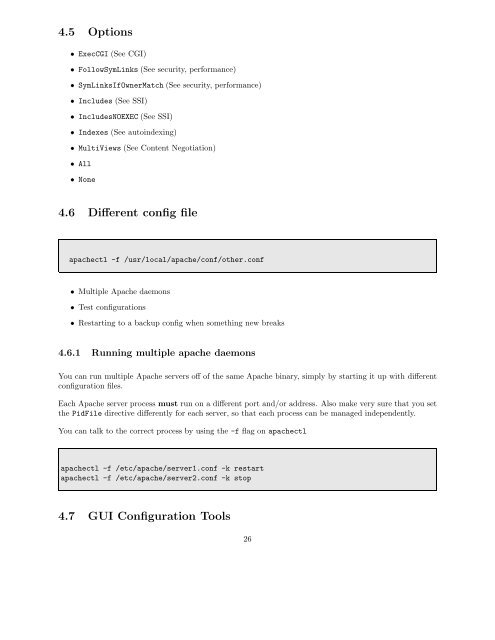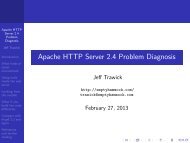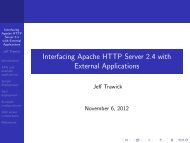Introduction to the Apache Web Server - ApacheCon
Introduction to the Apache Web Server - ApacheCon
Introduction to the Apache Web Server - ApacheCon
Create successful ePaper yourself
Turn your PDF publications into a flip-book with our unique Google optimized e-Paper software.
4.5 Options<br />
• ExecCGI (See CGI)<br />
• FollowSymLinks (See security, performance)<br />
• SymLinksIfOwnerMatch (See security, performance)<br />
• Includes (See SSI)<br />
• IncludesNOEXEC (See SSI)<br />
• Indexes (See au<strong>to</strong>indexing)<br />
• MultiViews (See Content Negotiation)<br />
• All<br />
• None<br />
4.6 Different config file<br />
apachectl -f /usr/local/apache/conf/o<strong>the</strong>r.conf<br />
• Multiple <strong>Apache</strong> daemons<br />
• Test configurations<br />
• Restarting <strong>to</strong> a backup config when something new breaks<br />
4.6.1 Running multiple apache daemons<br />
You can run multiple <strong>Apache</strong> servers off of <strong>the</strong> same <strong>Apache</strong> binary, simply by starting it up with different<br />
configuration files.<br />
Each <strong>Apache</strong> server process must run on a different port and/or address. Also make very sure that you set<br />
<strong>the</strong> PidFile directive differently for each server, so that each process can be managed independently.<br />
You can talk <strong>to</strong> <strong>the</strong> correct process by using <strong>the</strong> -f flag on apachectl<br />
apachectl -f /etc/apache/server1.conf -k restart<br />
apachectl -f /etc/apache/server2.conf -k s<strong>to</strong>p<br />
4.7 GUI Configuration Tools<br />
26
















